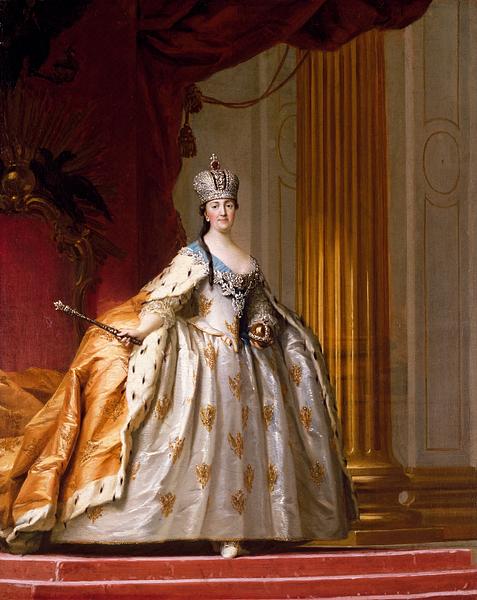Catherine II (1729–1796) was married to Charles Peter Ulrich, Duke of Holsten-Gottorp, who in January 1762 was proclaimed Emperor of Russia as Tsar Peter III. However, just six months later she orchestrated a coup d’état that overthrew her husband and placed her on the throne as Empress of Russia; a position she maintained for thirty-four years, becoming known as Catherine the Great.
Vigilius Eriksen was Catherine II’s favourite painter. She showered him with commissions and sat for him on several occasions.
[1] As painter at the Russian court from approximately 1757 to 1772, he executed several official portraits of Catherine II, and it was not unusual for him to later paint additional versions of these works in large as well as smaller formats. For example, the portrait of the Empress in the David Collection is a smaller version of an official, life-sized portrait that Eriksen executed in St. Petersburg in 1765.
[2]Catherine II stands majestically in the centre of the painting, poised in front of the imperial throne, which is covered with dark red fabric. Eriksen has used effective contrasts of light and colour to make the empress brightly luminous amidst the dark surroundings, commanding our full attention. A number of elements further testify to her status, power and authority as empress: Catherine II is wearing a dress in silver brocade and an ermine robe, both adorned with the imperial double-headed eagle. She wears the large imperial crown designed and executed in St. Petersburg in 1762 specifically on the occasion of her coronation. On a chain upon Catherine II’s bosom is the Order of St. Andrew, which was founded by Tsar Peter the Great (1672-1725) in 1698 and was at the time the highest and most distinguished of the Russian imperial orders of chivalry. In a final proclamation of sovereignty, she holds an orb in her left hand and a sceptre in her right.
Eriksen’s portrait was acquired by The David Collection in 1967.
Inv. no. 14/1967
Published in:
Erik Zahle (ed.): Danmarks malerkunst fra middelalder til nutid, 4. ed., København 1956, p. 102;
Troels Andersen: ”Vigilius Eriksen in Russia”, Artes: Periodical of the Fine Arts, I, October 1965, Copenhagen, p. 58 and ill. XXXVII;
Troels Andersen: ”Vigilius Eriksen, List of paintings 1757-1772”, Artes: Periodical of the Fine Arts, 1970, cat. 62;
Torben Holck Colding: “Om Vigilius Erichsen og hans Værksted i Rusland” in C.L. Davids Samling. Fjerde del, Jubilæumsskrift 1945-1970, København 1970, pp. 14-15 and 19;
Dansk kunst og kunsthåndværk, Davids Samling, København 1972, p. 9 og pl. 2;
Verner Jul Andersen: Dansk kunst og kunsthåndværk, Davids Samling, 2. ed., København 1983, cat. 396, ill. II;
Magnus Olausson: Katarina den stora & Gustav III, Nationalmuseum, Stockholm 1998, fig. 47, p. 102 and 106;
Alexej Smirnov: Svensk historia under vattnet: vrak i Östersjön berättar, Stockholm 2002, p. 155;
Nathalie Bondil (ed.): Catherine the Great:. Art for empire: masterpieces from the State Hermitage Museum, Russia, Art Gallery of Ontario, Montreal 2005, fig. 25, s. 138-139;
Thomas Lyngby (ed.): Danmark og zarernes Rusland 1600-1900: Katalog, Det Nationalhistoriske Museum, Frederiksborg Slot, Hillerød 2013, cat. 67, p. 37;
Lauritz G. Dorenfeldt: Kongeligt porcelæn: Brogetmalet porcelæn fra Den Kongelige Porcelainsfabrik 1775-1810, København 2016, p. 26;
Marie Betteley, David Schimmelpenninck van der Oye: Beyond Fabergé: Imperial Russian jewelry, Atglen 2020, p. 68
Rosalind P. Blakesley: “Catherine the Great’s Danish Portraitist: Projecting Majesty across the Baltic Sea”, Studia Historica Gedanensia, 13, 2022, pp. 170-171, note 27;
